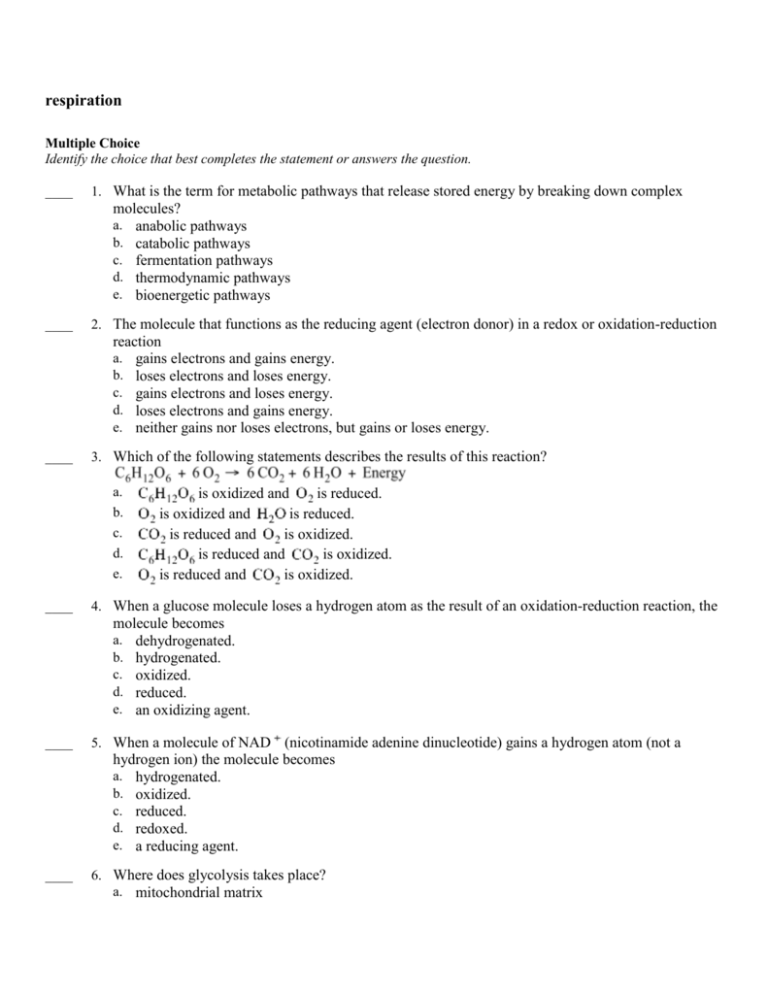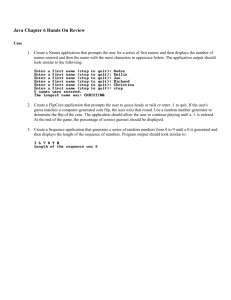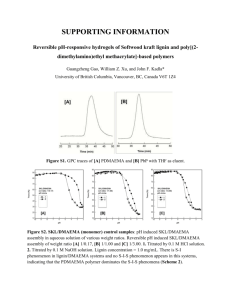respiration - TeacherWeb
advertisement

respiration Multiple Choice Identify the choice that best completes the statement or answers the question. ____ 1. What is the term for metabolic pathways that release stored energy by breaking down complex molecules? a. anabolic pathways b. catabolic pathways c. fermentation pathways d. thermodynamic pathways e. bioenergetic pathways ____ 2. The molecule that functions as the reducing agent (electron donor) in a redox or oxidation-reduction reaction a. gains electrons and gains energy. b. loses electrons and loses energy. c. gains electrons and loses energy. d. loses electrons and gains energy. e. neither gains nor loses electrons, but gains or loses energy. ____ 3. Which of the following statements describes the results of this reaction? a. b. c. d. e. ____ is oxidized and is reduced. is oxidized and is reduced. is reduced and is oxidized. is reduced and is oxidized. is reduced and is oxidized. 4. When a glucose molecule loses a hydrogen atom as the result of an oxidation-reduction reaction, the molecule becomes a. dehydrogenated. b. hydrogenated. c. oxidized. d. reduced. e. an oxidizing agent. ____ 5. When a molecule of NAD (nicotinamide adenine dinucleotide) gains a hydrogen atom (not a hydrogen ion) the molecule becomes a. hydrogenated. b. oxidized. c. reduced. d. redoxed. e. a reducing agent. ____ 6. Where does glycolysis takes place? a. mitochondrial matrix b. c. d. e. mitochondrial outer membrane mitochondrial inner membrane mitochondrial intermembrane space cytosol ____ 7. The ATP made during glycolysis is generated by a. substrate-level phosphorylation. b. electron transport. c. photophosphorylation. d. chemiosmosis. e. oxidation of NADH to NAD . ____ 8. The oxygen consumed during cellular respiration is involved directly in which process or event? a. glycolysis b. accepting electrons at the end of the electron transport chain c. the citric acid cycle d. the oxidation of pyruvate to acetyl CoA e. the phosphorylation of ADP to form ATP ____ 9. Which process in eukaryotic cells will proceed normally whether oxygen (O2) is present or absent? a. electron transport b. glycolysis c. the citric acid cycle d. oxidative phosphorylation e. chemiosmosis ____ 10. An electron loses potential energy when it a. shifts to a less electronegative atom. b. shifts to a more electronegative atom. c. increases its kinetic energy. d. increases its activity as an oxidizing agent. e. attaches itself to NAD . ____ 11. Why are carbohydrates and fats considered high energy foods? a. They have a lot of oxygen atoms. b. They have no nitrogen in their makeup. c. They can have very long carbon skeletons. d. They have a lot of electrons associated with hydrogen. e. They are easily reduced. ____ 12. In addition to ATP, what are the end products of glycolysis? a. and b. and pyruvate c. NADH and pyruvate d. and NADH e. , , and citrate ____ 13. Starting with one molecule of glucose, the "net" products of glycolysis are a. 2 NAD , 2 H , 2 pyruvate, 2 ATP, and 2 b. 2 NADH, 2 H , 2 pyruvate, 2 ATP, and 2 c. 2 , 2 pyruvate, 4 ATP, and 2 . d. 6 ,6 , 2 ATP, and 2 pyruvate. e. 6 ,6 , 36 ATP, and 2 citrate. . . ____ 14. During cellular respiration, acetyl CoA accumulates in which location? a. cytosol b. mitochondrial outer membrane c. mitochondrial inner membrane d. mitochondrial intermembrane space e. mitochondrial matrix ____ 15. How many carbon atoms are fed into the citric acid cycle as a result of the oxidation of one molecule of pyruvate? a. 2 b. 4 c. 6 d. 8 e. 10 ____ 16. How many molecules of carbon dioxide ( ) would be produced by five turns of the citric acid cycle? a. 2 b. 5 c. 10 d. 12 e. 60 ____ 17. How many reduced dinucleotides would be produced with four turns of the citric acid cycle? a. 1 and 4 NADH b. 2 and 8 NADH c. 4 and 12 NADH d. 1 FAD and 4 NAD e. 4 FAD and 12 NAD ____ 18. Starting with citrate, which of the following combinations of products would result from three turns of the citric acid cycle? a. 1 ATP, 2 , 3 NADH, and 1 b. 2 ATP, 2 , 1 NADH, and 3 c. 3 ATP, 3 , 3 NADH, and 3 d. 3 ATP, 6 , 9 NADH, and 3 e. 38 ATP, 6 , 3 NADH, and 12 ____ 19. Carbon dioxide ( ) is released during which of the following stages of cellular respiration? a. b. c. d. e. glycolysis and the oxidation of pyruvate to acetyl CoA oxidation of pyruvate to acetyl CoA and the citric acid cycle the citric acid cycle and oxidative phosphorylation oxidative phosphorylation and fermentation fermentation and glycolysis ____ 20. For each molecule of glucose that is metabolized by glycolysis and the citric acid cycle, what is the total number of NADH + a. 4 b. 5 c. 6 d. 10 e. 12 molecules produced? ____ 21. Cellular respiration harvests the most chemical energy from which of the following? a. substrate-level phosphorylation b. chemiosmotic phosphorylation c. converting oxygen to ATP d. transferring electrons from organic molecules to pyruvate e. generating carbon dioxide and oxygen in the electron transport chain ____ 22. During aerobic respiration, electrons travel downhill in which sequence? a. food citric acid cycle ATP NAD+ b. food NADH electron transport chain oxygen c. glucose pyruvate ATP oxygen d. glucose ATP electron transport chain NADH e. food glycolysis citric acid cycle NADH ATP ____ 23. During aerobic respiration, which of the following directly donates electrons to the electron transport chain at the lowest energy level? a. NAD b. NADH c. ATP d. ADP + e. ____ 24. The primary role of oxygen in cellular respiration is to a. yield energy in the form of ATP as it is passed down the respiratory chain. b. act as an acceptor for electrons and hydrogen, forming water. c. combine with carbon, forming . d. combine with lactate, forming pyruvate. e. catalyze the reactions of glycolysis. ____ 25. Inside an active mitochondrion, most electrons follow which pathway? a. glycolysis NADH oxidative phosphorylation ATP oxygen b. citric acid cycle electron transport chain ATP c. electron transport chain citric acid cycle ATP oxygen d. pyruvate citric acid cycle ATP NADH oxygen e. citric acid cycle NADH electron transport chain oxygen ____ 26. In chemiosmotic phosphorylation, what is the most direct source of energy that is used to convert ADP + to ATP? a. energy released as electrons flow through the electron transport system b. energy released from substrate-level phosphorylation c. energy released from ATP synthase pumping hydrogen ions from the mitochondrial matrix d. energy released from movement of protons through ATP synthase e. No external source of energy is required because the reaction is exergonic. ____ 27. Energy released by the electron transport chain is used to pump H+ ions into which location? a. cytosol b. mitochondrial outer membrane c. mitochondrial inner membrane d. mitochondrial intermembrane space e. mitochondrial matrix ____ 28. When hydrogen ions are pumped from the mitochondrial matrix across the inner membrane and into the intermembrane space, the result is the a. formation of ATP. b. reduction of NAD . c. restoration of the Na /K balance across the membrane. d. creation of a proton gradient. e. lowering of pH in the mitochondrial matrix. ____ 29. Where is ATP synthase located in the mitochondrion? a. cytosol b. electron transport chain c. outer membrane d. inner membrane e. mitochondrial matrix ____ 30. Each time a molecule of glucose ( many oxygen molecules ( a. 1 b. 2 c. 6 d. 12 e. 38 ) is completely oxidized via aerobic respiration, how ) are required? ____ 31. Which of the following produces the most ATP when glucose ( carbon dioxide ( ) and water? a. glycolysis b. fermentation c. oxidation of pyruvate to acetyl CoA ) is completely oxidized to d. citric acid cycle e. oxidative phosphorylation (chemiosmosis) ____ 32. Approximately how many molecules of ATP are produced from the complete oxidation of two molecules of glucose ( a. 2 b. 4 c. 15 d. 38 e. 76 ) in cellular respiration? ____ 33. Assume a mitochondrion contains 58 NADH and 19 . If each of the 77 dinucleotides were used, approximately how many ATP molecules could be generated as a result of oxidative phosphorylation (chemiosmosis)? a. 36 b. 77 c. 173 d. 212 e. 1102 Figure 9.3 ____ 34. The accompanying figure shows the electron transport chain. Which of the following is the combination of substances that is initially added to the chain? a. oxygen, carbon dioxide, and water b. NAD , FAD, and electrons c. NADH, , and protons d. NADH, , and electrons e. Oxygen and electrons ____ 35. Which of the following most accurately describes what is happening along this chain? a. Chemiosmosis is coupled with electron transfer. b. Each electron carrier alternates between being reduced and being oxidized. c. ATP is generated at each step. d. Energy of the electrons increases at each step. e. Molecules in the chain give up some of their potential energy. ____ 36. Which of the following couples chemiosmosis to energy storage? a. NADH b. c. cytochromes d. electron transport e. ATP synthase ____ 37. Which of the following normally occurs whether or not oxygen ( a. glycolysis b. fermentation c. oxidation of pyruvate to acetyl CoA d. citric acid cycle e. oxidative phosphorylation (chemiosmosis) ) is present? ____ 38. Which of the following occurs in the cytosol of a eukaryotic cell? a. glycolysis and fermentation b. fermentation and chemiosmosis c. oxidation of pyruvate to acetyl CoA d. citric acid cycle e. oxidative phosphorylation ____ 39. Which metabolic pathway is common to both cellular respiration and fermentation? a. the oxidation of pyruvate to acetyl CoA b. the citric acid cycle c. oxidative phosphorylation d. glycolysis e. chemiosmosis ____ 40. The ATP made during fermentation is generated by which of the following? a. the electron transport chain b. substrate-level phosphorylation c. chemiosmosis d. oxidative phosphorylation e. aerobic respiration ____ 41. In the absence of oxygen, yeast cells can obtain energy by fermentation, resulting in the production of a. b. c. d. e. ATP, , and ethanol (ethyl alcohol). ATP, , and lactate. ATP, NADH, and pyruvate. ATP, pyruvate, and oxygen. ATP, pyruvate, and acetyl CoA. ____ 42. An organism is discovered that consumes a considerable amount of sugar, yet does not gain much weight when denied air. Curiously, the consumption of sugar increases as air is removed from the organism's environment, but the organism seems to thrive even in the absence of air. When returned to normal air, the organism does fine. Which of the following best describes the organism? a. It must use a molecule other than oxygen to accept electrons from the electron b. c. d. e. transport chain. It is a normal eukaryotic organism. The organism obviously lacks the citric acid cycle and electron transport chain. It is an anaerobic organism. It is a facultative anaerobe. ____ 43. Glycolysis is thought to be one of the most ancient of metabolic processes. Which statement supports this idea? a. Glycolysis is the most widespread metabolic pathway. b. Glycolysis neither uses nor needs O2. c. Glycolysis is found in all eukaryotic cells. d. The enzymes of glycolysis are found in the cytosol rather than in a membraneenclosed organelle. e. Ancient prokaryotic cells, the most primitive of cells, made extensive use of glycolysis long before oxygen was present in Earth's atmosphere. ____ 44. Why is glycolysis considered to be one of the first metabolic pathways to have evolved? a. It produces much less ATP than does oxidative phosphorylation. b. It is found in the cytosol, does not involve oxygen, and is present in most organisms. c. It is found in prokaryotic cells but not in eukaryotic cells. d. It relies on chemiosmosis which is a metabolic mechanism present only in the first cells-prokaryotic cells. e. It requires the presence of membrane-enclosed cell organelles found only in eukaryotic cells. ____ 45. When muscle cells undergo anaerobic respiration, they become fatigued and painful. This is now known to be caused by a. buildup of pyruvate. b. buildup of lactate. c. increase in sodium ions. d. increase in potassium ions. e. increase in ethanol. ____ 46. You have a friend who lost 7 kg (about 15 pounds) of fat on a "low carb" diet. How did the fat leave her body? a. It was released as and . b. Chemical energy was converted to heat and then released. c. It was converted to ATP, which weighs much less than fat. d. It was broken down to amino acids and eliminated from the body. e. It was converted to urine and eliminated from the body. ____ 47. What is the reducing agent in the following reaction? Pyruvate + NADH + H Lactate + NAD a. oxygen b. NADH c. NAD d. lactate e. pyruvate ____ 48. The immediate energy source that drives ATP synthesis by ATP synthase during oxidative phosphorylation is a. the oxidation of glucose and other organic compounds. b. the flow of electrons down the electron transport chain. c. the affinity of oxygen for electrons. d. the H concentration gradient across the inner mitochondrial membrane. e. the transfer of phosphate to ADP. ____ 49. Which metabolic pathway is common to both fermentation and cellular respiration of a glucose molecule? a. the citric acid cycle b. the electron transport chain c. glycolysis d. synthesis of acetyl CoA from pyruvate e. reduction of pyruvate to lactate ____ 50. The final electron acceptor of the electron transport chain that functions in aerobic oxidative phosphorylation is a. oxygen. b. water. c. NAD . d. pyruvate. e. ADP. ____ 51. Cells do not catabolize carbon dioxide because a. its double bonds are too stable to be broken. b. has fewer bonding electrons than other organic compounds. c. is already completely reduced. d. is already completely oxidized. e. the molecule has too few atoms. ____ 52. Most from catabolism is released during a. glycolysis. b. the citric acid cycle. c. lactate fermentation. d. electron transport. e. oxidative phosphorylation. respiration Answer Section MULTIPLE CHOICE 1. 2. 3. 4. 5. 6. 7. 8. 9. 10. 11. 12. 13. 14. 15. 16. 17. 18. 19. 20. 21. 22. 23. 24. 25. 26. 27. 28. 29. 30. 31. 32. 33. 34. 35. 36. 37. 38. 39. 40. 41. ANS: ANS: ANS: ANS: ANS: ANS: ANS: ANS: ANS: ANS: ANS: ANS: ANS: ANS: ANS: ANS: ANS: ANS: ANS: ANS: ANS: ANS: ANS: ANS: ANS: ANS: ANS: ANS: ANS: ANS: ANS: ANS: ANS: ANS: ANS: ANS: ANS: ANS: ANS: ANS: ANS: B B A C C E A B B B D C B E A C C D B E B B E B E D D D D C E E D D B E A A D B A PTS: PTS: PTS: PTS: PTS: PTS: PTS: PTS: PTS: PTS: PTS: PTS: PTS: PTS: PTS: PTS: PTS: PTS: PTS: PTS: PTS: PTS: PTS: PTS: PTS: PTS: PTS: PTS: PTS: PTS: PTS: PTS: PTS: PTS: PTS: PTS: PTS: PTS: PTS: PTS: PTS: 1 1 1 1 1 1 1 1 1 1 1 1 1 1 1 1 1 1 1 1 1 1 1 1 1 1 1 1 1 1 1 1 1 1 1 1 1 1 1 1 1 TOP: TOP: TOP: TOP: TOP: TOP: TOP: TOP: TOP: TOP: TOP: TOP: TOP: TOP: TOP: TOP: TOP: TOP: TOP: TOP: TOP: TOP: TOP: TOP: TOP: TOP: TOP: TOP: TOP: TOP: TOP: TOP: TOP: TOP: TOP: TOP: TOP: TOP: TOP: TOP: TOP: Concept 9.1 Concept 9.1 Concept 9.1 Concept 9.1 Concept 9.1 Concept 9.1 Concept 9.1 Concept 9.1 Concept 9.1 Concept 9.1 Concept 9.1 Concept 9.2 Concept 9.2 Concept 9.3 Concept 9.3 Concept 9.3 Concept 9.3 Concept 9.3 Concept 9.3 Concept 9.3 Concept 9.3 Concept 9.3 Concept 9.4 Concept 9.4 Concept 9.4 Concept 9.4 Concept 9.4 Concept 9.4 Concept 9.4 Concept 9.4 Concept 9.4 Concept 9.4 Concept 9.4 Concept 9.4 Concept 9.4 Concept 9.4 Concept 9.5 Concept 9.5 Concept 9.5 Concept 9.5 Concept 9.5 SKL: SKL: SKL: SKL: SKL: SKL: SKL: SKL: SKL: SKL: SKL: SKL: SKL: SKL: SKL: SKL: SKL: SKL: SKL: SKL: SKL: SKL: SKL: SKL: SKL: SKL: SKL: SKL: SKL: SKL: SKL: SKL: SKL: SKL: SKL: SKL: SKL: SKL: SKL: SKL: SKL: Knowledge/Comprehension Knowledge/Comprehension Knowledge/Comprehension Knowledge/Comprehension Knowledge/Comprehension Knowledge/Comprehension Knowledge/Comprehension Knowledge/Comprehension Knowledge/Comprehension Knowledge/Comprehension Knowledge/Comprehension Knowledge/Comprehension Knowledge/Comprehension Knowledge/Comprehension Knowledge/Comprehension Application/Analysis Application/Analysis Application/Analysis Knowledge/Comprehension Knowledge/Comprehension Knowledge/Comprehension Application/Analysis Knowledge/Comprehension Knowledge/Comprehension Knowledge/Comprehension Knowledge/Comprehension Knowledge/Comprehension Knowledge/Comprehension Knowledge/Comprehension Knowledge/Comprehension Knowledge/Comprehension Knowledge/Comprehension Application/Analysis Application/Analysis Application/Analysis Knowledge/Comprehension Knowledge/Comprehension Knowledge/Comprehension Knowledge/Comprehension Knowledge/Comprehension Knowledge/Comprehension 42. 43. 44. 45. 46. 47. 48. 49. 50. 51. 52. ANS: ANS: ANS: ANS: ANS: ANS: ANS: ANS: ANS: ANS: ANS: E A B B A B D C A D B PTS: PTS: PTS: PTS: PTS: PTS: PTS: PTS: PTS: PTS: PTS: 1 1 1 1 1 1 1 1 1 1 1 TOP: TOP: TOP: TOP: TOP: TOP: TOP: TOP: TOP: TOP: TOP: Concept 9.5 SKL: Concept 9.5 SKL: Concept 9.5 SKL: Concept 9.5 SKL: Concept 9.6 SKL: Self-Quiz Questions Self-Quiz Questions Self-Quiz Questions Self-Quiz Questions Self-Quiz Questions Self-Quiz Questions Application/Analysis Synthesis/Evaluation Synthesis/Evaluation Knowledge/Comprehension Application/Analysis








